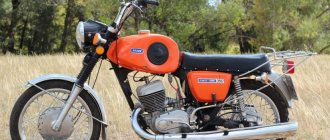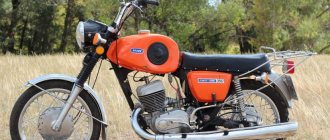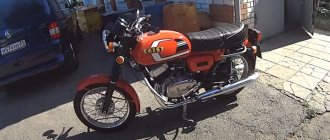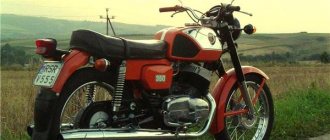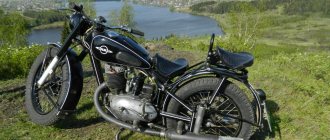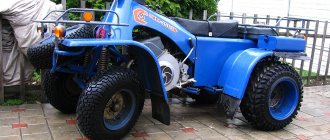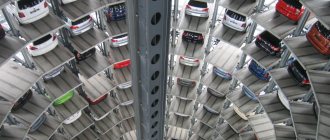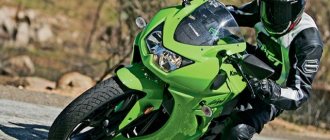The Voskhod motorcycle began its history at the plant named after. Degtyarev, who at that time produced about a million different anti-tank rifles. No one could have thought that along with weapons they would begin to produce motorcycles. However, despite doubts, on March 7, 1946, Voskhod rolled through the streets for the first time.
Of course, the Voskhod motorcycle, like any other vehicle, has many positive and negative sides. One of the most striking advantages is probably its low price and the ability to repair almost on the fly. This motorcycle is very common, and the network of parts suppliers is quite wide, so the owner of this bike will not have a problem finding or replacing failed spare parts.
Pros:
- unpretentious to repair;
- large tank (enough for 500-600 km);
- high-quality brakes;
- excellent volume to power ratio;
- In the city it has low fuel consumption.
Minuses:
- modest appearance;
- weak frame for difficult roads;
- The motorcycle is not suitable for bales and heavy loads.
But breakdowns themselves are quite rare, and they occur due to the negligence of their owners. Therefore, if you act responsibly, unpleasant situations can be avoided.
Technical characteristics of the Voskhod motorcycle
Motorcycles of this type have a two-stroke single-cylinder engine and a four-speed gearbox. These bikes have a simple but quite strong closed-type welded tubular frame mechanism. The motorcycle is extremely light in weight – about 110 kilograms. Its capacity was as much as 13 liters. The length was approximately 1930 millimeters, while the wheelbase did not exceed 1300 mm. The width of the motorcycle is 690 mm, and the height is only 1010 mm.
If we continue the conversation about the technical parameters of the Voskhod, we can say that the engine volume in the all-terrain vehicle was 173.8 cm3, and the highest power was about 7.37 kW at 5300 rpm. The G411 alternator itself could provide work, so operation is possible without a battery.
Price
The cost of the Voskhod-ZM motorcycle on the secondary market is low - on average 25-30 thousand rubles (depending on the condition it can range from 15 to 50 thousand rubles), which makes the purchase quite affordable.
The cost level is determined based on various indicators:
- general condition;
- technical characteristics;
- Year of release;
- availability of repairs;
- appearance.
The low mileage of the motorcycle guarantees its high demand.
Versions and photos of the Soviet motorcycle "Voskhod"
The first motorcycle "Voskhod" began in 1965. In comparison with its predecessor (K-175V), the single-cylinder two-stroke engine of the motorcycle has added power.
Motorcycle Sunrise 2
The road "Voskhod 2" replaced the initial model of this series, it was even more powerful than its "father", but this is where the main transformations ended, if you do not take into account its appearance. Updated headlights appeared, and the direction indicators became round. There were also improvements in the electronic ignition system and updated alarm devices were added. Compared to the previous model, these innovations are quite minor, but, nevertheless, they were a pleasant addition.
The new Voskhod 2 became a little faster and could reach its speed up to 95 km/h, but at the same time it “gained weight” by several kilograms.
In 1977, the improved Voskhod 2M came to replace it. The engine remains the same in volume, but has now become even more powerful. This modernization was achieved by increasing the configuration of the channels in the crankcase and cylinder. The changes also affected some details: the motorcycle suspension and shock absorbers were improved. The new bike became heavier, now weighing 121 kg and faster by as much as 10 km/h.
Following its predecessor, Voskhod 3 was released. The model, of course, has become significantly better than its predecessors. An updated intake system and brake system were installed. The driver's seat has now become more comfortable. But the maximum speed has not changed, despite the fact that the weight has increased, now it is 125 kg.
In 1984, Voskhod 3M was born. It was implemented properly and is quite reliable. The motorcycle continued its production until the end of 1992. Low and high beam indicators and a speedometer began to appear on the panel. The driver's footrests were installed and reclined. The maximum speed has not been changed, and the weight has become several kilograms less than that of Voskhod 3.
In 1985, Voskhod 3M-tourist was created. This version was equipped with strong safety arches, a completely updated steering wheel and travel equipment. But the weight, as well as the speed, were not changed.
Motorcycle tuning Voskhod
And the last reincarnation - Voskhod 3M-01, was created in 1989. Only the motorcycle engine with a reed valve was subject to significant modifications. With its help, it was possible to reduce fuel consumption to 4.2 liters per 100 km. The steering wheel has become somewhat wider, and thus more comfortable. And on this model, the Voskhod motorcycles completed their transformation, and the Sova brand continued production.
Nowadays, the production of motorcycles at the plant named after. Degtyarev is still in force, but there is now nothing in common between the Voskhod line and the plant. The latest modifications turned out to be completely unprepared for the current conditions of market competition.
Although the Voskhod motorcycle represents a classic of the last century, it is still popular in our time, and is famous for its unpretentiousness and cheap repairs. But new Ural motorcycles can compete with it.
Advantages and disadvantages
Motorcyclists note the excellent build quality of the motorcycle, which guarantees its durability. In addition, the following advantages of the Voskhod-3M motorcycle can be highlighted:
- speed and power have decent performance;
- ease of control and instant response to driver actions;
- unpretentiousness in maintenance;
- low price.
Among the disadvantages are the following:
- a lot of noise and vibrations when moving make motorcycle trips not very comfortable;
- rapid overheating due to the lack of cooling systems;
- will not work if there is no oil in gasoline;
- unattractive design.
Watch a video review of the Voskhod-3M motorcycle:
About sunrise and sunset from the Encyclopedic Dictionary of Brockhaus and Efron
For a place on the earth's surface whose northern or southern latitude is equal to φ, both phenomena occur only for those luminaries whose northern or southern declination is less than 90°−φ. So, for example, for St. Petersburg, whose latitude is about 60°, only those luminaries whose declination is less than 30° rise and set:
- luminaries whose northern declination is greater than 30° are always above the skyline of St. Petersburg,
- luminaries whose southern declination is greater than 30° always remain below the horizon.
Stars whose declination satisfies the above condition rise and set under a given latitude every day at the same moment in sidereal time, since their right ascension and declination, considering short periods of time, are almost constant; For them, the position of the points on the horizon at which they rise and set does not change either.
The sidereal times of rising and setting of other luminaries, as well as the position of these points on the horizon for them, change from day to day; for example, the points of sunrise and sunset in spring and summer in the northern hemisphere, when the declination of the sun is northern, deviate to the north from the points of east and west, while in autumn and winter, when the declination of the sun is southern, the deviation occurs to the south. On equinoxes, the sun rises in the east.
The ancients distinguished between helic, cosmic and acronictic sunrise and sunset.
- If the time of sunrise or sunset of a star fell in the morning (or evening) twilight, then the sunrise (or sunset) of the star was called helic by the ancients;
- the time of sunrise (or sunset) of a star, which coincided with the sunrise (or sunset) of the Sun, they called the cosmic sunrise (or sunset);
- the time of sunrise (or sunset) of a star, which coincided with the time of sunset (or sunrise) of the sun - acronictic sunrise (or sunset).
Model features
If you look at the photo of the Voskhod motorcycle, we will see a simple workhorse that is great for riding on different road surfaces . The bike's engine is equipped with improved cylinders and modified crankcases. The vehicle body was also slightly modernized.
On the road, the Voskhod motorcycle behaves very reliably and confidently, thanks to which it has earned the status of a reliable iron horse. At the same time, the model maintains its stability even with changes in speed.
Such a vehicle is also pleased with its good dynamics - the maximum speed is reached quite quickly. To accelerate to 60 km/h, the bike takes only 8 seconds
Cool video about a motorcycle from the past Voskhod 2:
Conclusion
There is no point in chasing the 2-M model specifically, unless, of course, you are a rabid collector. Any other “Voskhod” is no worse suited for restoration and even for operation. Restoring a bike to 100% original won't be cheap, but if you repair it with other parts that are more readily available, it can be an inexpensive alternative for riding around the countryside.
Specifications
| Maximum engine power: | 14 HP |
| Working volume: | 173.7 cm3 |
| Motor type (cylinder arrangement, number of strokes): | 1-cylinder, 2-stroke |
| Number of cylinders: | 1 |
| Number of valves: | |
| Intake type (Injector / Carburetor): | |
| Bore and stroke: | |
| Starting system (Electric starter, kick starter): | |
| Maximum speed in km/h: | 105 km/h |
| Cooling system: | Air |
| Transmission (gearbox): | Mechanical 4-speed |
| Clutch (Dry / Wet): | |
| Drive unit: | Chain |
| Frame: | Tubular steel, welded |
| Chassis | |
| Suspension (front/rear travel): | |
| Brakes (Front/Rear): | |
| Wheels / Tires / Rubber: | |
| Dimensions and weight | |
| Dimensions (Length / Width): | |
| Seat height: | |
| Ground clearance: | |
| Curb weight: | |
| Wheelbase: | 1300 mm |
| Weight: | 119 kg |
| Fuel tank capacity: | 12 l. |
| Battery capacity: | |
| Year of release: | |
| Country of Origin: |
Tuning options
Refinement of the design involves internal or external tuning. During internal modifications, the engine is rebuilt, driving parameters, suspension, and brakes are optimized. When external modifications are made, the motor vehicle is given a sporty style or it is converted into a chopper.
Features of internal tuning
Owners often rework the Voskhod-3M engine. To increase engine thrust, the factory paper air filter is replaced with foam filter elements. This helps reduce air exhaust friction. Then the jets and diffusers are polished using an abrasive material, the diameter of which affects the volume of fuel entering the engine.
To improve the fuel exhaust system, a new modernized carburetor is installed. From the existing pipe, take flanges for mounting on the cylinders, grind out aluminum bushings, and cut off the flange from the exhaust pipe. In an old carburetor, take a second flange. Using cold welding, the parts are connected.
The design is adjusted until it fits perfectly into the exhaust channels. Internal gaps are filled using epoxy glue.
Often rear adjustable shock absorbers are installed and sports tires are installed. When performing such tuning, the motorcycle becomes more aggressive and sporty.
Performing external tuning
In a sporty style
With a low seating position and a high front fork, there is a desire to modify the motorcycle in accordance with the sporty style. To do this, raise the rear shock absorbers and replace the exhaust pipe elbow. This way the exhaust pipe is level with the rear axle. Exhaust pipes with a larger diameter will improve the design and increase the traction of the bike.
External modifications can include painting, chrome plating, installation of nickel-plated arches instead of the old factory protection, installation of large rear-view mirrors, stepped seats and wheel tuning.
At the end of the tuning, a sports fairing is installed.
Chopper
When performing tuning for a chopper, shortened rear shock absorbers are cut off or purchased. Thanks to this replacement, the rear of the motorcycle will be lowered by several centimeters. The rear fork and wheel are replaced with wider ones. The angle of inclination of the front fork axis is replaced, and the cylinder covers are equipped with chrome plated cups. The same style is followed when tuning the headlights, rear lights, and dashboard.
Tuning for Cafe-bike
With such a modification, to reduce costs, they weld the rear part of the frame with their own hands, shorten the fork, trim and adjust other parts. For the steering wheel and seat, your own strength may also be sufficient. A headlight with a brake light is installed from trucks.
Most owners can carry out tuning on their own using only purchased parts due to the simplicity of the designs and the low cost of spare parts.
Bottom line
The Soviet-made 3M-Voskhod motorcycle is rightfully considered one of the most popular types of equipment in the 80-90s in the post-Soviet space. Possessing good characteristics and maintainability, the described unit had a decent design and decent driving characteristics, adapted to domestic roads, including rural areas.
The production of the model ended in 1993, but for a long time it occupied not the lowest place among domestically produced two-wheeled “iron horses”.
Links
Types of daily time Solar day: 24 hours • Sidereal day: 23 hours 56 minutes 4 seconds Related Articles Time • Regular time • Terminator • Polar day • Polar night • Day length • White nights When writing this article, material was used from the Encyclopedic Dictionary of Brockhaus and Efron (1890-1907).
Engine diagram Voskhod 3m
1 – spark plug A23; 2 – cylinder head; 3 – cylinder head gasket; 4 – cylinder; 5 – piston ring; 6 – piston; 7 – piston pin; 8 – needle bearing; 9 – cylinder gasket; 10 – connecting rod; 11 – bearing lubrication channel; 12 – ball bearing; 13 – right crankshaft oil seal; 14 – right main crankshaft journal; 15 – generator; 16 – movable gear of the second gear; 17 – primary shaft with gear; 18 – main gear; 19 – gearbox and clutch housing; 20 – clutch release rod; 21 – pin of the clutch release mechanism; 22 – gearbox oil seal; 23 – reverse gear sprocket; 24 – generator cover; 25 – crankcase (right half); 26 – gear shift shaft; 27 – crankcase (left half); 28 – trigger shaft; 29 – trigger spring; 30 – trigger sector; 31 – trigger gear; 32 – trigger ratchet; 33 – kickstarter shaft oil seal; 34 – kickstarter shaft oil seal cap; 35 – kickstarter lever; 36 – gear shift lever; 37 – clutch disc; 38 – adjusting screw; 39 – internal clutch drum; 40 – leading clutch disc; 41 – outer clutch drum; 42 – left main crankshaft journal; 43 – front drive sprocket; 44 – chain PV-9.525-1300; 45 – clutch cover; 46 – left crankshaft oil seal; 47 – ball bearing; 48 – bearing lubrication channel.
Similar articles:
- Do-it-yourself motorcycle repair
Consumer Reviews
According to users, although the unit in question does not have a modern design with chrome inserts and other innovations, it is easy to operate and maintain. Any owner could independently sort out this equipment piece by piece with minimal skills.
By and large, Voskhod-3M, the characteristics of which are discussed above, is a typical representative of the Soviet automotive industry, which, nevertheless, at one time was considered one of the best in a similar category. Its advantages include low maintenance and fuel requirements, low price, and the ability to overcome difficult terrain. On such routes, modern vehicles with similar parameters do not always cope.
Design
The design profession did not exist in the USSR, and stern designers were guided mainly by considerations of practicality. Voskhod 2M was the result of their labors, which is clearly visible from the photo: square, angular, without a hint of any grace, a kind of hard worker, strong, but unprepossessing. However, given the age of the model, now its design does not play a role, since this motorcycle is valuable in itself due to its advanced age.
Frequently asked questions
- What about the interchangeability of spare parts from other Voskhods? Everything is fine with the interchangeability of spare parts; many things fit from other ZiD motorcycles. Some units can be picked up even from the latest models, “Owl” and “Courier”.
- Is it possible to install a 6V generator on it? The original is nowhere to be found. The nominal voltage of the standard generator is 7V, but 6V is also most likely suitable.
- Is it possible to find a copy with a side stroller? There are no original strollers for this model and never have been. However, sometimes you can find “collective farm” versions with strollers from “IZh” or “Java” on sale.

